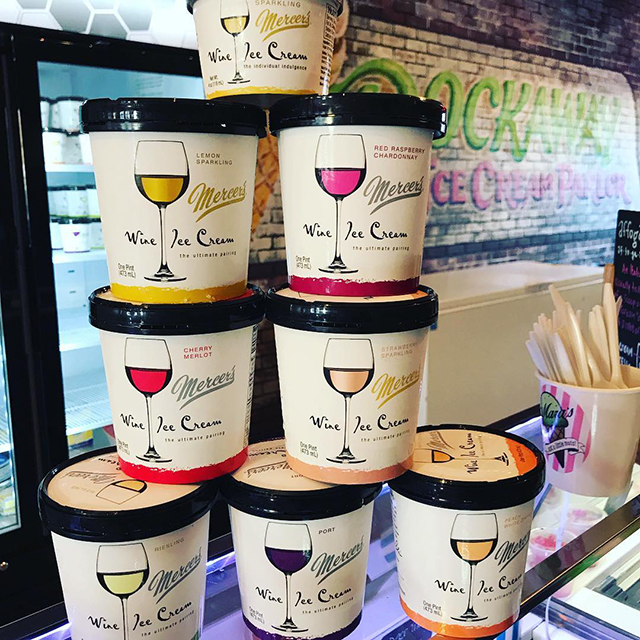by Paula D.
on March 19, 2019 6:20 pm in Food
As you probably know from Fionnuala O’Leary’s article a couple of months ago, I’m working at The Wave now as a member of the art/design team. I write about everything that’s going on in my life in this column, so I thought it was about time to write about my experience so far at my new job!
First off, going to the office has worked wonders for my mental health. I know longer feel like an old cat lady, peeking out of the lace curtains to see what the commotion is on the street. It’s refreshing to have some structure in my week – to put on a nice outfit, leave the house and have interactions with like-minded humans. A huge perk is having the best commute of anyone in NYC. I walk three blocks to get to The Wave building. I don’t pay for transportation or expensive lunches either. I almost feel bad about how good I have it.
During my day-to-day, I’m working alongside Janette Rappo, Mark Hogan and Judy Gardonyi. They’re the people behind the pages of what you’re reading right now. The graphic design team does an outstanding job, laying out our usual 56-pager. They’ve been so patient with me while I learn the ropes. I’ve interrupted Jeanette and Mark Hogan dozens of times asking questions, yet they never get flustered with me. Four weeks ago, I put a page number on the inside margin by mistake. (Yup, that was me, sorry!) Even with that doozy, Janette, Mark and Judy were very understanding.
Before the stories get to the art department, Mark Healey, Ralph Mancini, Fionnuala O’Leary and a shortlist of freelancers work their magic covering stories, conducting interviews, writing detailed accounts, fact checking, editing and proofing. Fionnuala is a witty social media pro and Ralph is a meticulous editor, not to mention they’re excellent journalists. The editorial dept. is a small operation with big determination.
When a story breaks, the news room heats up. I love that energy! The phones are ringing off the hook, conversations are happening and our Editor In Chief, Mark Healey is in the center of it all, doing what he does best… managing everything! I’ve learned a lot from Mark already, about the importance of local news reporting and the impact it has on a community. With all that’s on his plate, Mark makes sure our plates are also full, with work yes, but also with snacks from the kitchen, lunches on him and he keeps us caffeinated.
Bernadette Luina is our “all hands on deck” secretary. She takes unending phone calls, assists walk-ins, some of whom are tipsy, looking for Ship to Shore Wine Shop. She handles the classifieds, orders us Chinese food on Wednesdays and even helps layout a few pages here and there. She has the patience of Mother Teresa I swear! You’ll here Berni’s voice calling “Carol, we need a notary”. Carol Keenan along with lending out her “John Hancock”, is our accountant extraordinaire. Everyone loves Carol because she makes sure we get paid!
In addition to the overwhelming work involved with being a publisher, Walter Sanchez and his wife Tammy are our “pinch hitters”. They come in on Wednesdays and Thursdays to check the “big picture” of the weeks pages, helping the team get the paper to press on time. Walter and Tammy are 100% committed to the staff and The Wave Newspaper. It’s been a pleasure working for them.
A weekly publication is a fast paced environment. I don’t think people get how much work it is to produce a newspaper with pertinent content. And then you just start all over again the next week. On Thursdays when we go to print, it feels like an impossible task sometimes. But article by article, ad by ad, and page by page the paper comes together as a result of the whole team’s feverish work ethic at The Wave. I can’t tell you how happy I am to be a part of it all!
Previously published in The Wave.
Last Saturday I went to McDonald’s to get shamrock shakes for my friend Dave’s party. He’s never had one! But when I arrived, at first they didn’t know what I was talking about and then they said the machine was broken! Can you believe that?? On Rockaway St. Patrick’s Day… it’s ludicrous! I ranted my frustrations on Facebook and Mark Healey responded, reminding me that Mara’s Ice Cream Parlor (the former Uncle Louie G’s) has them!
After watching the parade shenanigans and visiting family uptown, I headed back, stopping at Mara’s on the way to my next party. I ordered the shakes and Mara herself adorned them with her signature shamrock shake toppings – whip cream, green pearl sprinkles, Lucky Charms, a candy rainbow – and if that wasn’t enough – a chocolate gold coin! They were stunning, almost too beautiful to eat. Mara is so nice and super friendly! It’s the first time I met her although we follow each other on Instagram.

While my shakes were blending Mara told me to expect a few new product surprises this summer. She also mentioned there’s wine ice cream in the fridge, buy one get the second free!!* Yes. WINE ICE CREAM. There are several flavors – Zinfandel, strawberry sparkling, cherry merlot, lemon sparkling, Riesling, port and red raspberry Chardonnay! Obviously I needed some. I decided on the strawberry sparkling and the Chardonnay. This would be the perfect gift for your wine enthusiast friend or to indulge, on a lazy Sunday night.

Photo via Facebook
Loaded with wine ice cream and my shamrock shakes, I walked into Dave’s party and everyone was “oohing and ahhing” over the festive bevs. And they tasted as good as they looked. The flavor is vanilla-like with a hint of mint. They’re thick and rich and go perfectly with Jameson! We had a blast spiking our Shamrock Shakes and slurping down the green goodness.

We still have a week until the official holiday. Pop in Mara’s and get these adorable Shamrock Shakes for your other celebrations. And if you love it (and you will), the ice cream parlor sells them year round!
Mara’s Ice Cream Parlor is open from 2pm to 9pm and till 10pm on weekends. Check out the new storefront facade and stop in for something sweet – 92-14 Rockaway Beach Blvd. Rockaway Beach, NY 11693. Follow on instagram for mouth-watering pictures and to learn about specials and new products @marasicecreamparlor.
*While supplies last.
In some ways, I’m a “basic” Long Island chick. I played lacrosse in high school. I love Billy Joel. I’m into Botox. But it may surprise you to learn that I’m also a Trekker. (Not a Trekkie. If you don’t know, don’t ask.)
My husband essentially forced me to watch the show back when we were dating. He would come over with Star Trek DVDs. We started with the original series but then jumped to Deep Space Nine, which Matt thought was a better introduction for Trek newbies. Essentially DS9 is a space soap opera – great plot lines, romance and action. It just happens to be set in outer space. I was hooked.
Last week, after a few glasses of “Klingon blood wine”, I had an awesome idea: there should be a Star Trek Convention this summer in Rockaway. It would be amazing. Before you stop reading, allow me to set the scene for you.
Picture, beings streaming off the ferry and the shuttle heading to the boardwalk dressed as Star Trek characters. Klingons will be drunk, getting in fights with Green Goblins (The Parks Dept.) on the Beach. Andorians will be sunbathing their blue skin. Each concession will host its own galactic party!
Low Tide Bar will transform into Quark’s, the local watering hole on Deep Space Nine. Your favorite bartenders dressed as Ferengi (ahem Rob Bryn, Emil Seager), will serve you Trek-themed otherworldly cocktails. Some ideas for possible drinks include:
* The Mind Meld
* The Pattern Buffer
* The Borg Queen
* Liquid Latinum
They’ll be picnic tables with gambling (ok, probably board games) with beautiful Dabo girl attendants distracting you from your earnings. And it wouldn’t be Quark’s without the holodeck. I’m thinking Will Farrell of Wilderness Yard in a teepee tent and some of his magical tinctures? That, in combination with a few Mind Melds, and you’ll feel like you’re in a virtual alternate reality. Holodeck, check.
Imagine Armin Shimerman himself shows up at our convention! It’s common for Star Trek actors to attend these conventions and Rockaway is a draw for everyone in the summertime. After all, the reason Captain Sisko earged Quark to run the bar on the starbase was to encourage interstellar commercial tourism, boosting the station’s economy. See where I’m going with this?
Caracas, I appropriately deem as Rissa, designation: “pleasure planet”. It’s a luxurious world where many in the binary system go on vacation. First Officer William T. Riker describes it best, “This place is called Risa, and believe me, Captain, it is a paradise. Warm tropical breezes, exotic foods, nothing to do but sit around all day.”
Trekkers will travel through the Neutral Zone (ie, walk the boardwalk) to reach Ten Forward (Rippers). Ten Forward is the crew lounge aboard the Galaxy-class USS Enterprise-D, the ship on a favorite of mine, Next Generation. Like Rippers, Ten Forward as spectacular views, is the social center of the ship and has a dedicated wait staff. I think Nick Bendick would make a great Guinan. Characters from all galaxies will be dancing on the tables at Rippers all night long!!!
Trekkers of Rockaway, set heading to RB Star Trek Convention – 2019. Make it so!
by Paula D.
on February 25, 2019 1:42 pm in Community
If you haven’t heard yet, I’m working in the art dept. at The Wave. I’ll have to write an official post explaining how lovely its been so far but in the mean time, check this link!






























